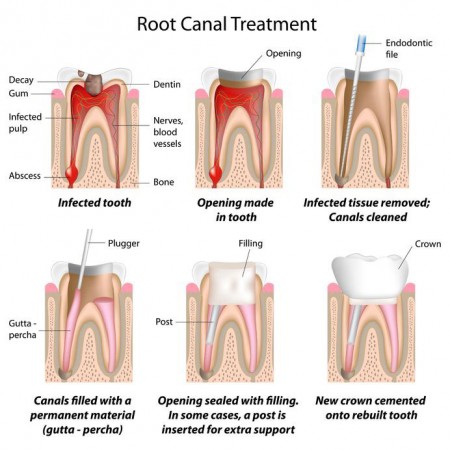Endodontic services that can save damaged teeth.
What is a root canal?

Why would I need a root canal?
Common symptoms that may indicate you need a root canal include pain when chewing with or tapping the tooth, sensitivity to hot or cold temperatures, and tenderness or red protrusions on the gums near the tooth.
These signs are indicative of damage to the tooth’s internal nerve. The pain that results from a damaged dental nerve can be excruciating because inflammation builds within the tooth and has nowhere to go. If the root of your tooth has been damaged by decay, infection, or trauma, it is likely that you will need to have a root canal performed. A root canal represents an opportunity to save your tooth from extraction.
“Very impressed with the staff – they always welcome me and know who I am”
We have been coming to Dr. Crabtree since we moved to Katy. Dr. Crabtree is very efficient with his work. He is also very personal and easy to talk to. I am also very impressed with the staff – they always welcome me and know who I am. They are very organized as well and will make sure you won’t miss your appointments by giving you courtesy reminders.
—Kim Taggert, Katy, TX

Because we can’t see the inside of a tooth you might think it’s solid throughout; but inside there is a hollow chamber that contains pulp tissue called the “nerve”. Each root of a tooth has a tunnel-like space called a canal that runs the full length of the root. The canal is smallest at the bottom end of the root (apex or tip) and gradually increases as it moves up the tooth to the pulp chamber. Each tooth has only one pulp chamber and at least one canal. Your anterior teeth will typically have only one root with one canal, while posterior teeth will have two to three roots and three to four canals.
Does a root canal deserve all the bad press it gets?
Root canals tend to have a poor reputation for acute pain, but a root canal can be pretty uneventful due to advancements in modern dentistry. It is impossible to say whether your root canal procedure will be completely painless, but your dentist will use anesthetics, pain control techniques, and modern technology to avoid causing any additional pain or discomfort. It is likely that most of your discomfort will be from the pain caused by your damaged nerve, which is what root canal treatment is designed to alleviate. Remember at the end of a root canal treatment is the prize of keeping your tooth.
How long does a root canal take?
The length of a root canal procedure varies depending on your individual circumstances, but most can be performed in one or two appointments. The more canals in your tooth the longer the procedure will take. In more difficult cases it may be necessary for you to schedule additional visits; in particularly complex cases we may refer you to a dentist that specializes in endodontics.
Will I need a dental crown too?
When the nerve is removed from inside a tooth so goes the blood supply within the tooth. The tooth naturally becomes brittle and as such is at increased risk for breakage. In some cases, a post is inserted for extra support. Back teeth that must withstand heavy chewing forces are almost always candidates for crown restorations. Front teeth may be candidates depending on the extent of decay or damage, and/or previous restorations following endodontic therapy. When necessary, the dentist will recommend a permanent crown be placed on the tooth shortly after the procedure to protect it. It is important to have the tooth crowned in a timely fashion to protect it from fracture. If your tooth breaks before it is restored, you could well lose the tooth to extraction – the very thing you were trying to avoid in the first place.
 We have been coming to Dr. Crabtree since we moved to Katy. Dr. Crabtree is very efficient with his work. He is also very personal and easy to talk to. I am also very impressed with the staff – they always welcome me and know who I am. They are very organized as well and will make sure you won’t miss your appointments by giving you courtesy reminders.
We have been coming to Dr. Crabtree since we moved to Katy. Dr. Crabtree is very efficient with his work. He is also very personal and easy to talk to. I am also very impressed with the staff – they always welcome me and know who I am. They are very organized as well and will make sure you won’t miss your appointments by giving you courtesy reminders.